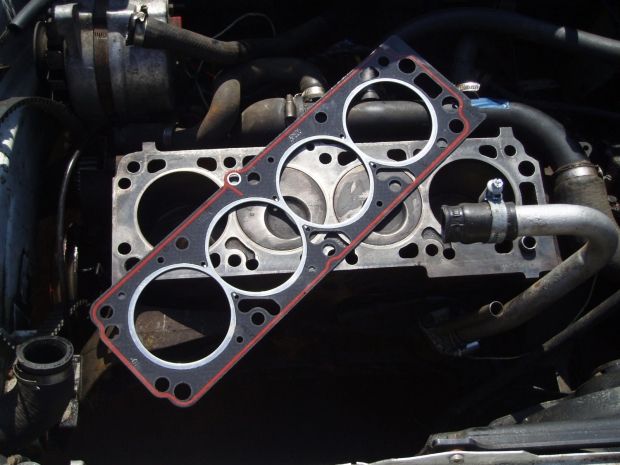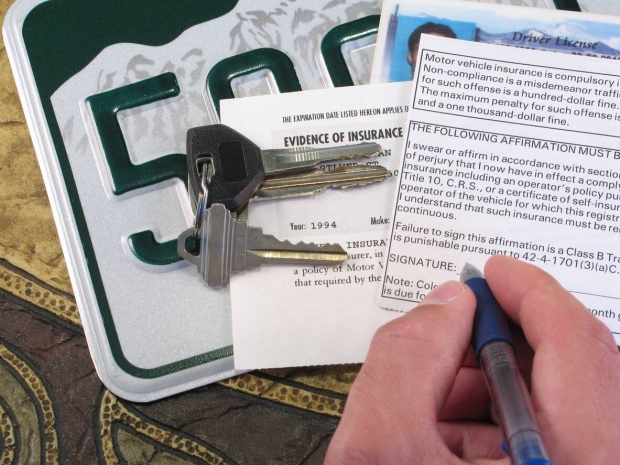A blown head gasket can mean two things: a massive problem for your engine and an expensive repair bill. Read this article to see how much it might cost you and decide if it’s worth fixing or if it’s better to junk your car for cash.
How Much Does a Head Gasket Replacement Cost?
The head gasket (also called a cylinder head gasket) in your car is a small and uncomplicated piece of metal (usually “multi-layer steel” on newer cars) with an essential purpose. Its job is to create a seal between the cylinder heads and the engine block that keeps combustion gasses (from the combustion of air and fuel inside the cylinder) inside and prevent engine oil and water-based coolant from getting inside the cylinder. When the combustion gasses escape, you’ll notice a decrease in power. When coolant or engine oil enters the cylinders, you might find blue or white smoke coming from the exhaust. Regardless of the symptom, your head gasket is an extremely important part of your engine, and if there’s damage to it, you will need to address it before it turns into a huge problem.
If you suspect you have a blown head gasket, take it to a professional to see if it can be fixed because the cost to replace a head gasket can be very high! While the actual head gasket price isn’t extremely high, the labor cost for head gasket replacement will be very expensive.
Here are some instances when you’ll need to bite the bullet and pay the head gasket replacement cost if you want to keep your car running smoothly.
- Low compression. Because it’s the head gasket’s job to create a seal between the cylinder heads and the engine block to prevent the escape of combustion gasses (which ultimately power your car), a broken head gasket means lower compression pressures. Lower compression inside your engine means a loss of power. Most of the time, this loss of power will be noticeable, but not always. The only way to properly check your compression is by taking your car to a mechanic and getting a compression test or a leak-down test. If you get either of these tests done and you have low compression in one or more cylinders, it’s likely because of a head gasket failure. If this is the case, a simple repair won’t fix it. This is a time when you’ll want to pay the hefty blown head gasket cost to fully replace your head gasket to prevent driving with not only a loss of horsepower but the potential for other issues to arise from a blown head gasket.
- Engine overheating. If your engine is overheating and your mechanic has ruled out any radiator issues, it may be from a blown head gasket. When the head gasket is damaged and doesn’t prevent combustion exhaust gasses from escaping the cylinder, extremely hot gas enters the cooling system and raises the temperature. This will cause your car to overheat. The other way a blown head gasket can cause overheating is again, because the head gasket seal is damaged, coolant from the cooling system will enter the cylinders. Because coolant isn’t a good lubricant, your engine will produce more friction and create more heat, which of course, will overheat your car.
If your cooling system is not to blame, your head gasket probably is. This is a time when asking “How much does it cost to replace a head gasket?” is a worthwhile question, because if you don’t replace it, you’ll be asking about replacing the cooling system, engine block, and possibly your transmission, too. Definitely fix the head gasket if your car is overheating, because overheating will bring on a whole new slew of problems.
Those are the two main reasons when you should definitely pay the blown head gasket repair cost because ignoring those problems will lead to more and more, often major, problems down the road.
A Sample of What a New Head Gasket Costs for Commonly Driven Cars
We have conducted market research in the USA and compiled a table of the average cost of a head gasket replacement for commonly owned cars. Have a look at it below so you can get an idea of what it might cost to replace your head gasket. Of course, these are only estimates, so your vehicle may cost you more or less.
Model | Labor | Parts | Total |
Ford F-Series | $2110-2692 | $249-512 | $2359-3204 |
Chevrolet Silverado | $784-954 | $230-591 | $978-1545 |
Ford Focus | $1079-1376 | $320-512 | $1399-1888 |
Toyota Camry | $1677-2139 | $387-641 | $2064-2780 |
Toyota Corolla | $795-1014 | $295-448 | $1090-1462 |
Nissan Altima | $1157-1477 | $263-433 | $1421-1910 |
Honda CR-V | $772-984 | $287-499 | $1059-1483 |
Honda Civic | $827-1055 | $226-496 | $1053-1551 |
Honda Accord | $693-884 | $331-408 | $1024-1292 |
Ford Fusion | $1346-1718 | $287-647 | $1633-2365 |
As you can see, the question “How much is a head gasket?” isn’t the issue; it’s the cost of labor for a head gasketreplacement. Many hours of disassembly and reassembly of the engine are required to replace the head gasket, resulting in a large tab for labor.
The cost to fix a blown head gasket, as you can see, is quite high. This may have you asking yourself, “Does head gasket sealer work?” The answer to that is: probably not. Even if it does work, it’s not a permanent fix. Because the head gasket is such an important part of your engine, and there are huge ramifications if it fails, the sealer is likely only a temporary solution. If you’re going to go the route of fixing it, it’s best to take it to a reputable mechanic and let them do the job.
Should You Repair or Replace Your Head Gasket?
The head gasket is such an important part of your engine that fixing an engine gasket by yourself isn’t recommended. The only time a repair of the head gasket (without needing to replace the car’s gasket) is if you catch it RIGHT when it happens and prevent the car from overheating. If the car has already overheated, it’s likely the crack in the cylinder head is large enough to cause problems and can’t be fixed on your own with a sealer. This happens because metal expands and contracts with fluctuations of temperatures from overheating (and cooling, as well). Like we said above, using sealant to fix a head gasket is only temporary, and continuing to drive your vehicle like that will cause serious issues down the road.
4 Signs Your Head Gasket Has Problems
There are a few signs that mean you’re having problems with your head gasket. Some issues overlap with problems you would see on other engine-related problems, so it’s best to take your car to a trusted auto mechanic to be looked at. If you see any of these symptoms, it’s best not to downplay them just because head gasket repair costs are very high. You will be better off spotting these symptoms and fixing them right as they appear instead of waiting any longer.
Bubbles in your radiator
Because the head gasket keeps compression gasses from escaping the cylinder, a compromised head gasket means this gas will escape. The lost compression gasses escape the cylinder and mix with the coolant in your engine’s cooling system. The easiest way to see if gasses are entering your cooling system is to look in the radiator.
Let your car completely cool down (usually two hours) and carefully remove the radiator cap. Start your engine and let it idle while looking at the coolant fluid in the neck of the radiator. If you see bubbles, it’s likely that you have a head gasket leak, costing you the seal that’s stopping the combustion gasses that are supposed to stay in the cylinder and instead are escaping and entering your cooling system. The easiest way to spot this issue is by looking into your (already cool) radiator and see if bubbles are forming inside as it idles.
While you’re looking inside the neck of your radiator, check to see the level of coolant. If you’re low on coolant but don’t have any visible coolant leaks, it may be because it’s not escaping through the cooling system but rather through the head gasket and into the cylinder — indicating a blown head gasket.
White exhaust smoke
In the opposite case as above — where gasses are escaping the cylinder and entering your cooling system — white smoke from your exhaust means there is coolant escaping your cooling system and entering the cylinders.
What happens inside the cylinder is air and fuel mix and burn together and create combustion, resulting in the pressure created inside the engine being transferred through the drivetrain that power your wheels. The important part of that equation is the combustion inside the cylinder — there’s a mini-explosion within the cylinders. When a head gasket seal is broken, coolant enters the cylinder and is burned inside along with the air and fuel mixture. This burned coolant will create a white smoke that can be seen coming from your exhaust. If you have white smoke coming from your exhaust, you likely have a head gasket that isn’t preventing coolant from entering places it shouldn’t be (like your engine)!
Mixed oil and coolant
Just like above, a blown head gasket means gasses and liquids (motor oil) from inside the engine are escaping, and coolant from the cooling system is entering. Neither of these is good, and both of them signify a blown head gasket.
To see if these liquids are mixing, first, check the radiator. If there are tiny black specks of oil floating on the surface of the liquid inside the neck of the radiator, it means the oil has entered. Next, check the oil dipstick. If there is coolant inside the engine, it will appear in the oil as a cream-colored foam. If you see this, it means coolant has entered the engine. If you see one or both of these problems, it’s almost certain you have a blown head gasket.
Engine overheating
Engine overheating can be both a cause and a result of a blown head gasket. Like we mentioned above, when you have a blown head gasket, the gasses from inside the cylinder (which are extremely hot!) escape and make their way into the cooling system. Because the coolant inside the cooling system needs to stay relatively cool for it to work properly, adding too much heat from leaking combustion gasses will make it too hot for it to do its job. Thus, your car overheats.
Junkcarsus is a Reputable Junk Car Buyer Working for 12 Years
If you find yourself googling “How much to fix a blown head gasket?” chances are you’re going to have to fork over a pretty penny if you want to get a gasket seal replacement because repairing it yourself is temporary, and you’ll likely experience much bigger problems down the road. If a leaking head gasket repair costs more than the car is worth, you might want to find a junk car buyer to trade your junk car for cash instead of spending all that money on a repair for a new head gasket.
JunkCarsUS, with over 12 years in the junk car industry and locations all over the USA, is the number one junk car buyer in your area. We will take nearly any car in any condition (even with a blown head gasket!) and will offer you top dollar for it. We are so confident in our cash offers that we offer the highest price guarantee out of any junk car buyer!
Not only are we the highest paying company, we’re also the easiest to use! We have a simple three-step process that can have your car off your property with cash in hand on the same day.
- Call us at (855) 547-1550 and speak to one of our friendly customer service representatives. Give them the make, model, year, condition, and mileage on your car, and we’ll give you a cash offer on the spot.
- Accept your offer and arrange a convenient time for you for our tow truck driver to come to your location.
- Then have it towed away for FREE! That’s right. There are no hidden costs when you work with JunkCarsUS, and that includes towing.
But what about paperwork? Don’t worry. We have been buying junk cars for so long and have filled out so many forms we know exactly what information goes where. That means we bring it already filled out and all you have to do is sign on the dotted line.
So if you need a liquid head gasket repair, and it’s going to cost you more than the car is even worth, call us at (855) 547-1550 or fill out an online application and see how you can change a costly repair bill into money in your pocket!
FAQ
What is the role of the cylinder head gasket?
The head gasket is a small metal part of an internal combustion engine, and its task is to create a seal between the cylinder heads and the cylinder block. Thus, it retains the products of combustion and prevents the leakage of gasses from the combustion chamber, as well as oil and coolant from the channels connecting massive parts. The head gasket is a critical part of a car engine, and there can be a big problem if it breaks.
How to detect if your head gasket is faulty?
To come to the conclusion that you have a head gasket problem, there are a few signs and symptoms you need to look out for. One of these signals is bubbles in the radiator, which are formed as a result of the fact that gas is leaking from the cylinder. A faulty cylinder head gasket may also be indicated by a small amount of coolant. Another sign that your head gasket is bad is white smoke from the exhaust. This may indicate that the liquid flows out of the cooling system and enters the cylinders. A blown cylinder head gasket is also indicated by the mixing of engine oil and coolant. And overheating of the engine is a common cause and consequence of a damaged cylinder head gasket.
When is it necessary to replace the cylinder head gasket?
When there is a question about the proper functioning of the car, there are cases when you have to refuse to repair the cylinder head gasket and purchase a new one. The first such condition is low compression. The cylinder head gasket is responsible for creating a seal and preventing leaks, so low compression pressure is indicative of power loss and can also cause other problems. The second situation is the engine overheating. Damage to the cylinder head gasket results in obstruction of the exhaust gasses from the cylinder, and hot gas increases the temperature. In these two cases, the blown gasket is no longer repairable.





